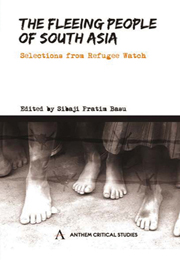Book contents
- Frontmatter
- Contents
- Acronyms and Abbreviations
- Foreword by Ranabir Samaddar
- Preface
- ETHICAL ISSUES
- LAWS
- SOUTH ASIA
- INDIA
- Introduction
- Population Displacement in India: A Critical Overview
- Reporting from Gagan Geer: A Kargil War Refugee Camp
- Barricaded Kashmiri Pandits Letting Go the Right to Return?
- Homeless and Divided in Jammu and Kashmir
- Internal Displacement in North-East India: Challenges Ahead
- The North-East Today: Displacing Identities, Displaced Identities
- Tibetan Refugees in India: Surviving in Exile
- Unrest and Displacement: Rajbanshis in North Bengal
- Adivasis in Coal Mining
- GENDER
- INTERVIEW/CORRESPONDENCE
- REPRESENTATIONS
- Index
Reporting from Gagan Geer: A Kargil War Refugee Camp
from INDIA
Published online by Cambridge University Press: 05 March 2012
- Frontmatter
- Contents
- Acronyms and Abbreviations
- Foreword by Ranabir Samaddar
- Preface
- ETHICAL ISSUES
- LAWS
- SOUTH ASIA
- INDIA
- Introduction
- Population Displacement in India: A Critical Overview
- Reporting from Gagan Geer: A Kargil War Refugee Camp
- Barricaded Kashmiri Pandits Letting Go the Right to Return?
- Homeless and Divided in Jammu and Kashmir
- Internal Displacement in North-East India: Challenges Ahead
- The North-East Today: Displacing Identities, Displaced Identities
- Tibetan Refugees in India: Surviving in Exile
- Unrest and Displacement: Rajbanshis in North Bengal
- Adivasis in Coal Mining
- GENDER
- INTERVIEW/CORRESPONDENCE
- REPRESENTATIONS
- Index
Summary
In war, all attention focuses on war news. The soldiers are the main concern of the media. This is natural. However, this one-sided coverage often ignores the plight of the civilian population who are affected by the war. Non-combatant civilians get killed, maimed and dispossessed. […] There is enough evidence to show that during war the border population gets pushed around by the very army, which is supposed to protect it. The media also tends to ignore or play down the plight of the war refugees, as these stories are perceived as less important.
It has been reported that the ongoing war in Kargil has created about 35,000 refugees. I was told by an official of the Jammu and Kashmir government that the heavy shelling by Pakistani forces in Akhnoor sector of Jammu has forced about 70,000 persons to leave their homes and take refuge in refugee camps set up in school buildings and tents. While the government claimed that all arrangements were made for proper relief of the refugees in Kargil and Jammu sectors, there were newspaper reports that the government had failed to provide even the basic necessities to the refugees. […] A few newspapers had reported that in the Kargil sector civilians were forced to work as porters for the army without any pay while others claimed that the people of the Kargil region were willingly carrying loads for the army.
- Type
- Chapter
- Information
- The Fleeing People of South AsiaSelections from Refugee Watch, pp. 234 - 238Publisher: Anthem PressPrint publication year: 2009



